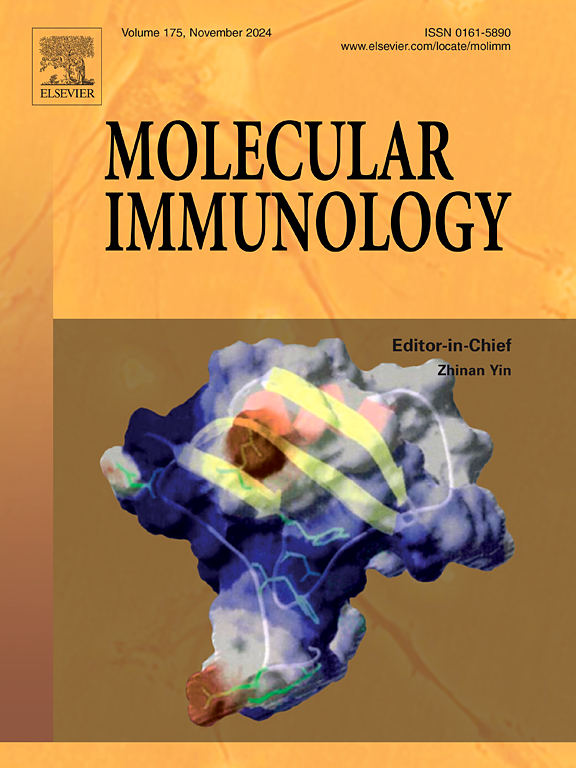I-Ak MHC II类分子的构象变体携带不同的免疫肽
IF 3.2
3区 医学
Q2 BIOCHEMISTRY & MOLECULAR BIOLOGY
引用次数: 0
摘要
主要组织相容性(MHC) II类分子可以基于跨膜结构域GxxxG二聚化基序的不同配对而以两种不同的构象状态存在(即M1-和m2 -配对MHC II类分子)。M1-和m2 -配对MHC II类分子驱动不同水平的T细胞活化和B细胞信号传导;因此,不同的肽负载会影响不同抗原/表位引发的免疫反应水平。在之前对单个模型抗原的研究中,我们发现来自bcr结合抗原的肽可以选择性地装载到M1配对的I-Ak II类上,而来自同一抗原的液相处理的肽可以同时装载到M1和m2配对的I-Ak上。为了扩大这一分析,我们测定了从小鼠B细胞中分离的m1配对的免疫肽组和总I-Ak类分子。通过比较两种免疫肽体以及源蛋白(抗原),一幅图突出了每一类II型构象对来自不同亚细胞区室的抗原的独特通路。两种免疫肽的序列分析表明,两种II类构象的肽结合槽高度相似。对Ii类相关的不变链衍生肽的分析显示,存在一组嵌套的非clip肽,这些肽主要与m1配对的Ii类相关,可能在典型肽结合槽之外。总之,这些结果进一步强调了M1-与m2配对的MHC II类分子的差异肽负载,并支持差异肽负载可能影响整体免疫反应的观点。本文章由计算机程序翻译,如有差异,请以英文原文为准。
Conformational variants of I-Ak MHC class II molecules carry distinct immunopeptidomes
Major histocompatibility (MHC) class II molecules can exist in two distinct conformational states based on alternative pairing of transmembrane domain GxxxG dimerization motifs (i.e., M1- and M2-paired MHC class II). M1- and M2-paired MHC class II molecules drive different levels of T cell activation and B cell signaling; consequently, differential peptide loading would impact the level of immune response elicited by various antigens/epitopes. In previous studies of a single model antigen, we show that while peptide from BCR-bound antigen is selectively loaded onto M1-paired I-Ak class II, peptide from fluid phase processing of the same antigen is loaded onto both M1- and M2-paired I-Ak. To expand this analysis, we determined the immunnopeptidomes of M1-paired vs. total I-Ak class II molecules isolated from murine B cells. By comparing the two immunopeptidomes as well as the source proteins (antigens), a picture emerges highlighting the unique access each class II conformer has to antigens from different subcellular compartments. Sequence analysis of the two immunopeptidomes suggests a high degree of similarity between the peptide binding grooves of the two class II conformers. Analysis of class II-associated invariant chain (Ii)-derived peptides reveals the robust presence of a nested set of non-CLIP peptides that associate primarily with M1-paired class II, likely outside of the canonical peptide binding groove. In total, these results further highlight the differential peptide loading of M1- vs. M2-paired MHC class II molecules and support the idea that differential peptide loading could impact overall immune responsiveness.
求助全文
通过发布文献求助,成功后即可免费获取论文全文。
去求助
来源期刊

Molecular immunology
医学-免疫学
CiteScore
6.90
自引率
2.80%
发文量
324
审稿时长
50 days
期刊介绍:
Molecular Immunology publishes original articles, reviews and commentaries on all areas of immunology, with a particular focus on description of cellular, biochemical or genetic mechanisms underlying immunological phenomena. Studies on all model organisms, from invertebrates to humans, are suitable. Examples include, but are not restricted to:
Infection, autoimmunity, transplantation, immunodeficiencies, inflammation and tumor immunology
Mechanisms of induction, regulation and termination of innate and adaptive immunity
Intercellular communication, cooperation and regulation
Intracellular mechanisms of immunity (endocytosis, protein trafficking, pathogen recognition, antigen presentation, etc)
Mechanisms of action of the cells and molecules of the immune system
Structural analysis
Development of the immune system
Comparative immunology and evolution of the immune system
"Omics" studies and bioinformatics
Vaccines, biotechnology and therapeutic manipulation of the immune system (therapeutic antibodies, cytokines, cellular therapies, etc)
Technical developments.
 求助内容:
求助内容: 应助结果提醒方式:
应助结果提醒方式:


